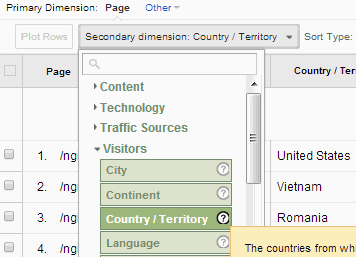Make Best Use Of Coverage Precision With Additional Measurement in Google Analytics
Recognizing exactly how to make the most of reporting accuracy with additional dimensions in Google Analytics can considerably enhance the depth of insights obtained from data analysis. By integrating additional dimensions tactically, online marketers can discover concealed patterns and correlations that might not be instantly noticeable when evaluating primary metrics alone.
Recognizing Secondary Measurements in Google Analytics
Secondary dimensions permit individuals to section and even more study information past the primary measurement picked. While the main measurement may present the complete number of web page sights, adding a secondary measurement such as 'source/medium' can supply insights into where the web traffic stemmed from.
Additionally, recognizing second dimensions is important for producing a lot more personalized records customized to particular organization objectives. By selecting the best mix of main and secondary measurements, analysts can discover patterns, trends, and connections that may or else remain covert. This nuanced approach to information analysis encourages services to make informed decisions based on an extensive understanding of user behavior across different measurements.

Exactly How to Apply Second Measurements
When leveraging second measurements in Google Analytics, the useful application involves picking particular data parameters to further refine understandings past the key dimension's scope. To use second dimensions properly, begin by accessing the record or dataset where you desire to dive deeper right into the information. Within Google Analytics, locate the primary measurement that you are presently evaluating. When determined, click the dropdown food selection identified "Additional Measurement." This activity will certainly disclose a listing of added specifications that can be included in your analysis. Choose the secondary measurement that lines up with your analytical objectives, such as 'Source/Medium,' 'Device Category,' or 'Area.' By selecting an additional measurement, you can acquire a lot more detailed understandings right into customer habits, demographics, or acquisition channels. Keep in mind that second measurements help supply context and granularity to your primary measurement information, allowing you to draw out more actionable and significant understandings from your Google Analytics records.
Leveraging Secondary Measurements for Insights
Making use of secondary dimensions in Google Analytics enables for an extra thorough evaluation of information, offering valuable insights beyond the main dimension's scope. By leveraging second dimensions, customers can dig deeper right into the performance metrics of their site or app, uncovering surprise patterns and fads that may not be immediately noticeable when only checking out main dimensions.
One trick benefit of using additional measurements is the capability to sector and filter information a lot more specifically. This can help marketing professionals and experts better comprehend the habits of certain customer segments, such as new site visitors versus returning site visitors, or web traffic originating from different geographic areas.
Moreover, second measurements enable customers to compare and contrast various data factors within the very same report, offering a more all natural sight of performance (Secondary Dimension in Google Analytics). Coupling the key dimension of touchdown web pages with additional dimensions like gadgets or demographics can expose which pages are most efficient in engaging customers on various devices or from different group teams.
Fundamentally, leveraging additional measurements in Google Analytics encourages users to extract richer understandings from their information, causing even more enlightened decision-making and ultimately, boosted efficiency.
Finest Practices for Secondary Dimensions
When examining data in Google Analytics, recommended you read including secondary dimensions effectively boosts the deepness of understandings originated from the primary metrics. To make one of the most out of secondary dimensions, it is important to stick to ideal methods that make sure exact and purposeful reporting. It is essential to choose additional dimensions that align with the primary metric you are evaluating. Selecting appropriate secondary measurements aids in giving context and a clearer understanding of the information being examined.
In addition, it is suggested to restrict the number of additional measurements made use of in a solitary report to stay clear of overwhelming the analysis with too much information. Focusing on a few crucial secondary dimensions at a time can result in even more workable and focused understandings. Furthermore, consider trying out various mixes of second and primary dimensions to discover one-of-a-kind patterns and patterns that might not appear when looking at the information in isolation.
Advanced Analysis Methods With Second Dimensions
Checking out elaborate data partnerships via the critical application of additional dimensions can unveil nuanced understandings that elevate the deepness of analysis in Google Analytics. By combining second measurements with main information collections, advanced analysis techniques can be used to extract useful info.
Additionally, additional dimensions can improve the evaluation of conversion paths by giving added context. Understanding the numerous touchpoints an individual interacts with prior to transforming can be important in maximizing the customer trip - Secondary Dimension in Google Analytics. By using second dimensions to look into specifics such as website traffic resources or devices made use of, marketing experts can customize methods to target high-converting networks efficiently
Final Thought

To enhance data evaluation and gain much deeper insights right into customer actions, comprehending additional measurements in Google Analytics is critical - Secondary Dimension in Google Analytics. Additional measurements enable customers to sector and further dissect information beyond the key measurement picked. While why not look here the key measurement might show the overall number of web page sights, adding a second dimension such as 'source/medium' can offer insights into where the web traffic stemmed from.When leveraging second dimensions in Google Analytics, the functional application includes choosing particular data specifications to further improve understandings past the key measurement's range. Bear in mind that additional dimensions aid give context and granularity to your key dimension my sources data, allowing you to draw out even more purposeful and actionable understandings from your Google Analytics reports